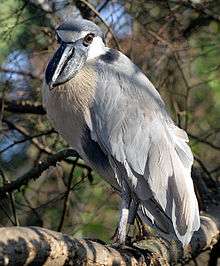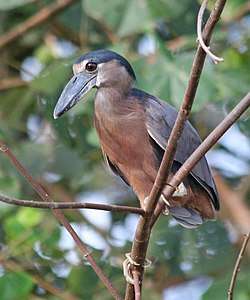Boat-billed heron
| Boat-billed heron | |
|---|---|
 | |
| Scientific classification | |
| Kingdom: | Animalia |
| Phylum: | Chordata |
| Class: | Aves |
| Order: | Pelecaniformes |
| Family: | Ardeidae |
| Genus: | Cochlearius Brisson, 1760 |
| Species: | C. cochlearius |
| Binomial name | |
| Cochlearius cochlearius (Linnaeus, 1766) | |
| Synonyms | |
| |

The boat-billed heron (Cochlearius cochlearius), colloquially known as the boatbill, is an atypical member of the heron family, and was formerly thought to be in a monotypic family, Cochlearidae. It lives in mangrove swamps from Mexico south to Peru and Brazil. It is a nocturnal bird, and breeds semi-colonially in mangrove trees, laying 2–4 bluish white eggs in a twig nest.
Description
The boat-billed heron grows to about 54 cm long. Adult boat-billed herons are pale grey to white in color, with chestnut colored abdomens and black flanks. The massive broad scoop-like bill, which gives rise to this species' name, is mainly black. They are also adorned with a crest which is thought to be used in mate attraction as they are larger in males. The sexes are similar in appearance, the main differences being that females are slightly smaller, grayer in appearance, and have shorter crests than males.[2] Newly hatched nestlings have green-yellow skin, with their upperparts covered in gray down feathers. Their upper bill is black and they have green-yellow legs. Juveniles are darker in color than adults and lack a crest.[3]
Distribution and habitat
Boat-billed herons range from Mexico to Peru, Brazil, northeastern Argentina.[4] They are non-migratory birds that tend to live in seasonal lagoons and estuaries, and will nest in mangroves.[5][6]
Diet
Boat-billed herons feed on shrimp and small fish such as Dormitator latifrons, a species of sleeper goby.[5][7] They tend to forage in vegetative streams, shallow water, and lagoons. When foraging in streams they will use low hanging branches and mangrove roots to stand over the water. In ponds they will walk slowly through the water up to 10 cm deep or will forage near the water’s edge.[5] In order to capture prey they will lunge at fish or scoop the surface of the water with their bills which are uniquely shaped for this method of capture.[5] Additionally, they have been observed using two different feeding techniques; standing and slowly stalking prey, or disturbing the water and chasing prey.[7] Boat-billed herons will forage nocturnally, and have been seen leaving the roost 30 minutes after sundown to feed. It has been observed that they do not feed when a light source is present such as daylight, moonlight, or artificial light.[6][5] One study hypothesized that in order to forage for food in the dark and in shallow, muddy water, their bills are sensitive to touch which helps them feel for their prey.[6]
Breeding
Boat-billed Herons breed during the rainy season and have been recorded producing two clutches during this time, laying their first clutch in February during the end of the dry season.[4] Their clutch sizes range from 2 to 4 eggs, with more eggs being laid during the first nesting period than the second.[8] They usually nest in colonies but have been observed nesting solitarily. Human disturbance can lead to a decrease in reproductive success as herons tend to avoid human contact and will abandon nests if necessary.[8]
References
Notes
- ↑ BirdLife International (2012). "Cochlearius cochlearius". IUCN Red List of Threatened Species. Version 2013.2. International Union for Conservation of Nature. Retrieved 26 November 2013.
- ↑ Rand, A. L. (April 1966). "A Display of the Boat-Billed Heron, Cochlearius cochlearius". The Auk. 83 (2): 304–306. doi:10.2307/4083025. JSTOR 4083025.
- ↑ Haverschmidt, F. (January 1969). "Notes on the Boat-Billed Heron in Surinam". The Auk. 86 (1): 130–131. doi:10.2307/4083548. JSTOR 4083548.
- 1 2 Gomez, Jaime; Gil-Delgado, Jose A.; Monros, Juan S. (August 2001). "Double-Brooding in the Boat-Billed Heron". Waterbirds: The International Journal of Waterbird Biology. 24 (2): 282. doi:10.2307/1522043. JSTOR 1522043.
- 1 2 3 4 5 Kushlan, James A. (September 2009). "Feeding Repertoire of the Boat-Billed Heron (Cochlearius cochlearius)". Waterbirds. 32 (3): 408–414. doi:10.1675/063.032.0305.
- 1 2 3 Mock, Douglas W. (1975). "Feeding Methods of the Boat-Billed Heron, a Deductive Hypothesis". Auk. 92 (3): 590–592.
- 1 2 Biderman, John O.; Dickerman, Robert W. (March 1978). "Feeding Behavior and Food Habits of the Boat-billed Heron (Cochlearius cochlearius)". Biotropica. 10 (1): 33. doi:10.2307/2388102. JSTOR 2388102.
- 1 2 Gómez, J; Gil-Delgado, JA; Monrós, JS (December 2006). "Breeding success of a colony of Boat-billed Herons Cochlearius cochlearius (Ciconiiformes: Ardeidae) in pasturelands of Costa Rica". Revista de Biologia Tropical. 54 (4): 1131–4. PMID 18457150.
Bibliography
External links

- Photos of the boat-billed heron
